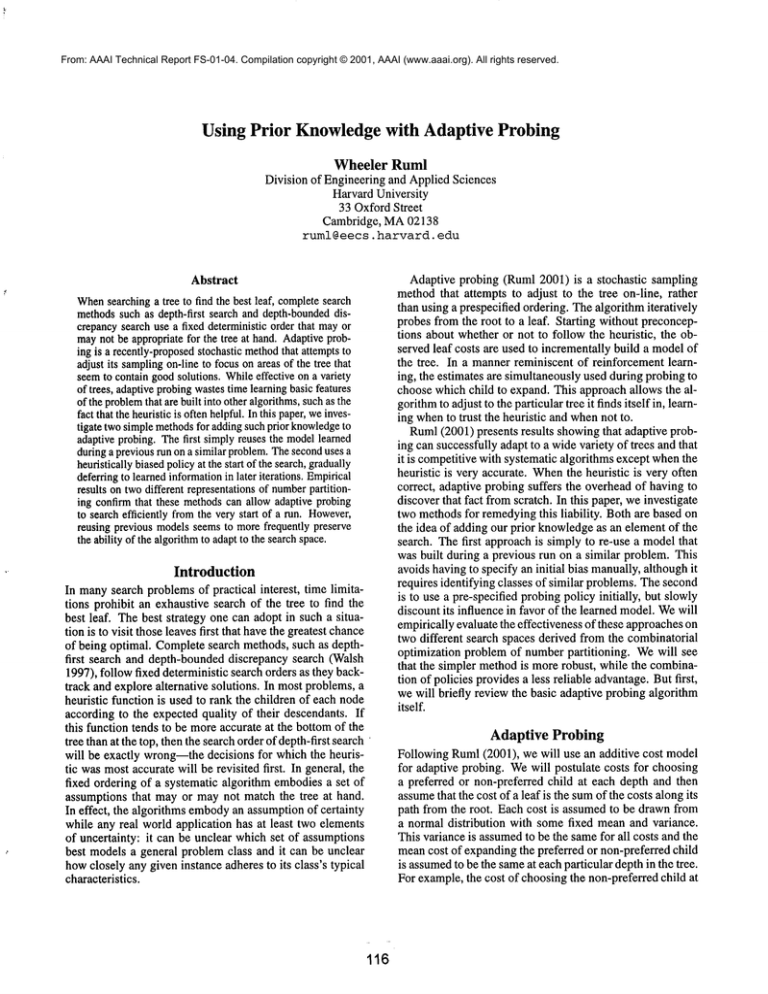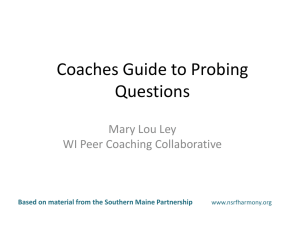
From: AAAI Technical Report FS-01-04. Compilation copyright © 2001, AAAI (www.aaai.org). All rights reserved.
Using Prior Knowledgewith Adaptive Probing
Wheeler Ruml
Division of Engineering and Applied Sciences
Harvard University
33 OxfordStreet
Cambridge, MA02138
ruml@eecs,harvard, edu
Abstract
Whensearchinga tree to find the best leaf, completesearch
methods
such as depth-first search and depth-bounded
discrepancysearch use a fixed deterministicorder that mayor
maynot be appropriatefor the tree at hand.Adaptiveprobing is a recently-proposed
stochastic methodthat attemptsto
adjust its samplingon-lineto focuson areas of the tree that
seemto containgoodsolutions. Whileeffective on a variety
of trees, adaptiveprobingwastestimelearningbasic features
of the problem
that are built into otheralgorithms,suchas the
fact that the heuristicis oftenhelpful.In this paper,weinvestigate twosimplemethodsfor addingsuchprior knowledge
to
adaptiveprobing.Thefirst simplyreuses the modellearned
duringa previousrun on a similar problem.Thesecondusesa
heuristicallybiasedpolicyat the start of the search,gradually
deferringto learnedinformation
in later iterations. Empirical
results on twodifferent representationsof number
partitioning confirmthat these methodscan allow adaptiveprobing
to search efficiently fromthe very start of a run. However,
reusingprevious modelsseemsto morefrequently preserve
the ability of the algorithmto adaptto the searchspace.
Introduction
In manysearch problemsof practical interest, time limitations prohibit an exhaustive search of the tree to find the
best leaf. The best strategy one can adopt in such a situation is to visit those leaves first that havethe greatest chance
of being optimal. Completesearch methods, such as depthfirst search and depth-boundeddiscrepancy search (Walsh
1997), follow fixed deterministic search orders as they backtrack and explore alternative solutions. In most problems,a
heuristic function is used to rank the children of each node
according to the expected quality of their descendants. If
this function tends to be moreaccurate at the bottomof the
tree than at the top, then the search order of depth-first search
will be exactly wrong--the decisions for which the heuristic was mostaccurate will be revisited first. In general, the
fixed ordering of a systematic algorithm embodiesa set of
assumptions that mayor maynot match the tree at hand.
In effect, the algorithms embodyan assumptionof certainty
while any real world application has at least two elements
of uncertainty: it can be unclear which set of assumptions
best modelsa general problem class and it can be unclear
howclosely any given instance adheres to its class’s typical
characteristics.
116
Adaptive probing (Ruml 2001) is a stochastic sampling
methodthat attempts to adjust to the tree on-line, rather
than using a prespecified ordering. The algorithmiteratively
probes from the root to a leaf. Starting without preconceptions about whether or not to follow the heuristic, the observed leaf costs are used to incrementally build a modelof
the tree. In a mannerreminiscent of reinforcement learning, the estimates are simultaneouslyused during probing to
choosewhich child to expand. This approach allows the algorithmto adjust to the particular tree it finds itself in, learning whento trust the heuristic and whennot to.
Ruml(2001) presents results showingthat adaptive probing can successfully adapt to a wide variety of trees and that
it is competitive with systematic algorithms except whenthe
heuristic is very accurate. Whenthe heuristic is very often
correct, adaptive probing suffers the overheadof having to
discoverthat fact fromscratch. In this paper, we investigate
two methodsfor remedyingthis liability. Both are based on
the idea of adding our prior knowledgeas an element of the
search. The first approachis simply to re-use a modelthat
was built during a previous run on a similar problem. This
avoids havingto specify an initial bias manually,althoughit
requires identifying classes of similar problems.The second
is to use a pre-specified probingpolicy initially, but slowly
discount its influence in favor of the learned model. Wewill
empirically evaluate the effectiveness of these approacheson
two different search spaces derived from the combinatorial
optimization problem of numberpartitioning. Wewill see
that the simpler methodis more robust, while the combination of policies providesa less reliable advantage.But first,
we will briefly review the basic adaptive probing algorithm
itself.
Adaptive Probing
Following Ruml(2001), we will use an additive cost model
for adaptive probing. Wewill postulate costs for choosing
a preferred or non-preferred child at each depth and then
assumethat the cost of a leaf is the sumof the costs alongits
path from the root. Each cost is assumedto be drawnfrom
a normal distribution with somefixed meanand variance.
This variance is assumedto be the samefor all costs and the
meancost of expandingthe preferred or non-preferred child
is assumedto be the sameat each particular depth in the tree.
For example,the cost of choosingthe non-preferred child at
-3"
depth 23 is assumedto be the sameat all nodes at depth 23.
For a tree of depth d and branchingfactor b, this modelwill
havedb parametersfor the costs, plus one for the variance.
To estimate these parameters, we use the observed leaf
costs. If aj (i) is the cost of takingchild i at depthj and Ik is
the cost of the kth leaf seen, probingthree times in a binary
tree of depth three might give the following information:
-4-
i/’~.~
Ui \
~\: \.
!i/;~ ~’~
;~i\
13~-~."
i.~ .,.
i
Random
......
ILDS --DDS......
DFS....
Adaptive -Adaptive w/Prior .....
-..,
t ..............
~ ......... ~ ...............
T .......................
-5-
a0(0)
ao(O)
--F
+
ao(1)+
al(0)
al(O)
al(1)+ a2(O)
+ a2(O)
,
a2(1) =
=/1
=/z
Weuse the perceptronlearning algorithmto update the aj (i)
according to ~(lk - [k)/d, wherethe learning rate r] is set
to 0.2. If we assume the costs at each level are independent, then the variance can be estimated from the observed
variance in leaf costs.l The only complication is that the
observedvariance will be magnifiedaccording to the difference in the meansat each level--if they differ, we will see
variance even if each cost has none. Happily,this correction
term is easy to compute(Ruml2001).
To use the model, we select each action at a node according to the probability that it leads to solutions will lower
costs (ie, that it has the lowermean).Giventhat we knowthe
estimated means and variance for each action and we know
howmanytimes we have selected each of them, this can be
computedusing a standard statistical test for the difference
of twosamplemeans.This test is sensitive both to the difference betweenthe costs of the actions and to the numberof
times each one has been tried. For a given level of variance,
an action either has to have a muchlower meancost or we
have to have tried it manytimes before we will give it high
probability of being actually lower. Toprevent the algorithm
from eventually convergingto a single path, the probability
of choosing any action is clampedat 0.05Wd,which ensures
at least one deviation on 95%of probes.
Bygiving the non-preferredchildren relatively high costs
at shallow depths and costs at deep depths that are comparable to the preferred children, this modelshould be able
to express behavior similar to depth-first search. Similarly, a preference for the heuristic at deep depths but not
a shallow ones would mimic depth-bounded discrepancy
search (Walsh1997), and a moderatepreference at all levels
should produce behavior somewhatakin to limited discrepancy search (Harvey & Ginsberg 1995; Korf 1996).
.
.......
x_
Leaves Seen
Figure 1: Searching the greedy representation of number
partitioning. Error bars indicate 95%confidence intervals
around the meanover 20 instances, each with 128 44-digit
numbers.
simplest wayof avoiding a prolongedinitial learning period
is to begin with an estimated model. Morespecifically, we
can use the costs estimated from a previous run on a similar
problem, while setting the variance to c~ and the recorded
numberof counts for each action to 0. This should improve
the accuracy of our estimated costs, speedingour identification of the preferred child as useful, while still allowingthe
algorithmplenty of latitude to exploreand revise the costs as
it gradually becomesconfident in its estimates and focuses
the search.
Wewill test this methodin two different search trees derived from the combinatorial optimization problem of number partitioning. The objective in a numberpartitioning
problemis to divide a given set of numbersinto twodisjoint
groups such that the difference betweenthe sumsof the two
groups is as small as possible. It was used by Johnsonet
al. to evaluate simulated annealing (1991), Korf to evaluate
his improvementto limited discrepancy search (1996), and
Walshto evaluate depth-boundeddiscrepancy search (1997).
To encourage difficult search trees by reducing the chance
of encountering a perfectly even partitioning (Karmarkaret
al. 1986), we used instances with 64 25-digit numbersor
128 44-digit numbers. Common
Lisp, which provides arbitrary precision integer arithmetic, was used to implement
the algorithms. All results are normalizedas if the original
numbers were between 0 and 1. To better approximate a
normaldistribution, the logarithmof the partition difference
was used as the leaf cost.
Reusing Learned Models
With db parameters and a single observed leaf cost per
probe, adaptive probing will take O(db) probes to estimate
the costs of choosing each child. Whilethe ability to adjust to any possible configurations of costs is admirable, it
is unlikely that the heuristically preferred child is actually
significantly worsethan the others. Wewouldlike to avoid
havingto spendthe time to learn this, while still maintaining
the flexibility to changethe modelif evidence suggests we
have encounteredone of these rare situations. Perhaps the
Greedy Number Partitioning
The first type of search tree we will examineis derived
from a straightforward greedy encoding of the problem. The
numbers are sorted in descending order and then each decision places the largest remaining numberin a partition,
preferring the smaller partition. Figure 1 comparesthe performanceof adaptive tree probing with depth-first search
(DFS), improvedlimited discrepancy search (ILDS), depth-
lWeignore, at our peril, the fact that the probingwill tend
to convergeto high-qualitysolutions, therebydistorting our estimates.
117
-3’
i\
"........
’
-6-
Random.....
DDS
......
Adaptive -Adaptivew/Prior .....
ILDS --DFS....
~
|~ixN
~/:,;. ~...r~
’~.
-4" ~ ".
~\ ~’. T .....
~.x
I~, \ "’,.., |
~".....................~ ........
.8
"1"
.............................................
~. -,o
-7"
\
2001000
Random
......
Adaptive -Adaptive w/Prior .....
DDS......
DFS....
1LDS- - -
-12
T
i-...........
-I-...............
600;000
400;000
Nodes Generated
800’,000
1,000,000
Nodes Generated
Figure 2: Performance on the greedy representation as a
function of nodes generated.
Figure 3: Searching the CKKrepresentation of numberpartitioning problems.
boundeddiscrepancy search (DDS), and completely random
tree probing. Adaptive probing was run twice-the first time
with its model’scosts initialized to zero and the secondtime
with the costs that were estimated by a previous run on a
different probleminstance. To provide a comparisonof the
algorithms’ search orders, the horizontal axis represents the
numberof leaves seen.
The figure shows that adaptive probing, in addition to
learning to explore a profitable part of the search space, benefits from the prior knowledge. While tabula rasa adaptive probing needs to see approximately1,500 leaves before
overtaking the systematic algorithms, the estimates transferred from the previous problemlead the algorithm directly
to goodsolutions.
AlthoughFigure 1 showsthat adaptive probing with transferred knowledgequickly learns a good search order, it ignores the overheadthat is inherent in restarting at the root
with each probe. Figure 2 corrects for this factor, showing
performanceas a function of the numberof nodes (both internal and leaves). Both adaptive probing and DDSsuffer
the maximumpossible overhead compared to DFS, which
generates roughly one internal node per leaf. This is reflected in the figure, as DFSfinds superior solutions when
given the same numberof node generations. Althoughprior
knowledgeprovides a benefit, it is not enoughto overcome
the overhead of adaptive probing. Adaptive probing is competitive with ILDS,although results using only 64 numbers
(which appear in Figure 4) indicate that adaptive probing
surpasses ILDSas problem size grows.
in the list according to the remainingdifference they represent. This representation creates a very different search
space fromthe greedy heuristic, as the heuristic tends to be
extremely accurate.
Figure 3 presents the performance of the search algorithms as a function of the numberof nodes generated. Randomprobing would appear off the top of the plot. ILDS
performs best in this domain, indicating that the heuristic
tends to be inaccurate with equal probability at all depths.
Ordinaryadaptive probingtakes a long time to learn that the
heuristic is usually accurate everywhere,although it looks
as if it mayeventually approach the systematic algorithms’
performance. Whenimbued with prior knowledge, adaptive probing quickly approaches DDS(which suffers similar node generation overhead). The benefit of using prior
knowledgeseemsto be greater in this search space than in
the greedy one, even though it is the harder one for plain
adaptive probing. Whenthe knowledgeis harder to acquire,
receiving it in advancerepresents a greater savings.
CKKNumber Partitioning
A more sophisticated representation for numberpartitioning, called CKK,was suggested by Korf (1995), based
the heuristic of Karmarkarand Karp (1982). The essential
idea is to postpone the assignment of numbersto particular partitions and merelyconstrain pairs of numberto lie in
either different bins or the samebin. Numbersare considered in decreasing order and constrained sets are reinserted
Blending Search Policies
While reusing an old model is easy and seems remarkably
effective, it is only possible if one has the luxury of previous experience with a similar problem. If the previous
problemhas a very different distribution of leaf costs, the
initial bias can be counter-productive. Anothermethodfor
taking advantageof our a priori expectation that the heuristic is beneficial is to behaveat first accordingto that belief,
while continuing to learn a fresh modelof the tree. Wecan
then gradually reduce the frequency with which we make
our decisions according to the prejudiced policy and begin
to rely moreheavily on our experience in the tree at hand.
While this methodapplies even in the absence of experience with similar problems,it requires a prior judgmenton
howquickly to makethe switch. This is essentially the same
problemas deciding howmuchto trust the initial bias.
In the experimentsreported below, we used a multiplicatire discounting policy. At the first probe, we use the prior
118
-3-
-4.
-6"
DDS
......
Biased
......
MixedAdaptive.....
Adaptive -ILDS---
~
Adaptive -Mixed
Adaptive
...........
:::
-7"
"\,..
.o
-5’
-8"
-6’
-9-
ioo’,ooo 2oo’,oQo
3oo’.0o0
NodesGenerated
40o10oo ~oo’,ooo
Nodes
Generated
Figure 5: Searching the CKKrepresentation of numberpartitioning.
Figure 4: Searching the greedy representation of number
partitioning instances, each with 64 25-digit numbers.
-6-
Adaptive -BlendedAdaptive.....
Biased
..........
\
\
bias with probability 1. After every probe, this probability
is multiplied by a constant such that, after 15d iterations, we
are as likely to use the current estimated modelas we are to
use the prior bias. 2 In effect, this creates a changingblend
of the initial policy and the current model.Foran initial policy, we use an algorithm whichselects the preferred child
with the maximum
probability that would be allowed under
adaptive probing (recall that we clampedthe probability of
any child as a safeguardagainst completeconvergenceof the
algorithm).
:::
-8
-10
-12
Evaluation
The empirical performance of blending policies was mixed.
Figure 4 showsalgorithm performanceusing the greedy representation of numberpartitioning instances with 64 numbers. Besides plain adaptive probing and the blended policy,
we also showthe performanceof a biased probing algorithm
that just uses the initial policy of the blendedalgorithm.This
biased probing algorithm performs on par with DDSin the
greedysearch space, but seemsto be a little worsethan plain
adaptive probing. The blended adaptive probing algorithm
seems equivalent to the plain. On larger problems, however, the blended policy was eventually surpassed by plain
adaptive probing. This might be caused by the very skewed
distribution of exampleson whichthe modelis trained.
In the CKKsearch space, policy blending seemedto work
reasonably well. Figure 5 showsthe performanceof the algorithms on 64-number problems. The blended algorithm
follows the biased probing algorithmat first, then switches
over to mimic the adaptive one. Unfortunately, the good
performanceof the initial biased policy seemsto provide little benefit to the modellearned by the adaptive component.
Figure 6 shows performance on larger problems. Here, the
modellearned by the blended algorithm seemsto have benefitted fromits initial experience,althoughthe algorithmstill
suffers a significant stagnant period during the transition in
whichlittle improvement
is seen. Use of a shorter or longer
2Thisconstantis
0.51/(15d).
I
119
200’.000 ,®’.000
~00’.00o soo’.0oo
1,~,~
NodesGenerated
Figure 6: Searching the CKKrepresentation of instances
with 128 numbers.
blending time seemedto result in worse performancein preliminary experiments on small problems. Using an abrupt
changeoverrather than a gradual blending also led to the
learning of a poor model.
Related Work
Muchwork has been done on using learned models to guide
heuristic optimization (Boese, Kahng, & Muddu1994;
Baluja 1997; Baluja & Davies 1998) although few authors
have explicitly investigated integrating prior knowledgeor
transferring problem-solving experience between problems.
The X-STAGEalgorithm (Boyan & Moore 2000) performs
a similar task in the context of improvement
search instead
of tree search. The STAGE
algorithm learns a model during search that predicts whenan initial solution will yield
goodresults with hill-climbing (or a similar algorithm). This
modelis used to intelligently restart after the hill-climbing
has reached a local maximum
by switching temporarily to
hill-climbing accordingto the model’sprediction of a solu-
tion’s potential as a starting place (whichmightbe different
from its quality). In X-STAGE,
several initial training problems are run and a separate modelis learned on each using
STAGE.These models are then used to solve a new problem by having each modelvote on whether or not to accept
a proposedmodificationto the starting solution. This avoids
worryingabout having to scale a modelto appropriate values
for use on a newproblem,but does not allow any adaptation
to the newprobleminstance.
Horvitz et al. (2001) use runs on training data to learn
modelof running time, and then use this modelto derive a
restart policy for a randomizedbacktracking search. This
high-level wrapperapproachcould be used on top of the approach we pursue here, whichfocuses on the structure of the
search space rather than the black-boxbehavior of a solver.
Conclusions
Systematictree search algorithmsfail to exhibit a fundamental trait of intelligent behavior: they do not adapt to their
surroundings. Purely adaptive algorithms, on the other hand,
are too general to exhibit high performancein the commonly
encounteredsearch spaces in which the heuristic maybe assumedto be helpful. Weinvestigated two methodsfor using
prior knowledgewith an adaptive probing algorithm. The
simplest one, merely reusing the action costs estimated on
a similar problem, seemedto perform the best. An attempt
to blend an a priori policy with the learning algorithm gave
someimprovement,but seems prone to leading to ineffective
learning. Onewayto circumventthese difficulties wouldbe
to allow a biased adaptive probing algorithm to recognize
whenits training data is unrepresentativeand initiate further
exploration on its own. This is an important direction for
future work.
Horvitz, E.; Ruan, Y.; Gomes,C.; Kautz, H.; Selman, B.;
and Chickering, M. 2001. A bayesian approach to tackling
hard computational problems. In Proceedings of UAI-01.
Johnson, D. S.; Aragon, C. R.; McGeoch,L. A.; and
Schevon, C. 1991. Optimization by simulated annealing: An experimental evaluation; Part II, graph coloring
and numberpartitioning. Operations Research 39(3):378406.
Karmarkar, N., and Karp, R. M. 1982. The differencing
method of set partitioning. Technical Report UCB/CSD
82/113, ComputerScience Division, University of California, Berkeley.
Karmarkar,N.; Karp, R. M.; Lueker, G. S.; and Odlyzko,
A.M.1986. Probabilistic analysis of optimumpartitioning.
Journal of Applied Probability 23:626-645.
Korf, R. E. 1995. Fromapproximateto optimal solutions:
A case study of number partitioning. In Proceedings of
IJCAI-95.
Korf, R. E. 1996. Improvedlimited discrepancy search. In
Proceedings of AAAI-96, 286-291. MITPress.
Ruml, W. 2001. Incomplete tree search using adaptive
probing. In Proceedings of lJCAl-01, 235-241.
Walsh, T. 1997. Depth-bounded discrepancy search. In
Proceedings of lJCAI-97.
Acknowledgments
Manythanks to Stuart Shieber and the Harvard AI Research
Groupfor helpful suggestions and comments
relating to this
work.
References
Baluja, S., and Davies, S. 1998. Fast probabilistic modeling for combinatorial optimization. In Proceedings of
AAAI-98.
Baluja, S. 1997. Genetic algorithms and explicit search
statistics. In Mozer,M. C.; Jordan, M.I.; and Petsche, T.,
eds., Advancesin Neural Information Processing Systems
9.
Boese, K. D.; Kahng, A. B.; and Muddu, S. 1994. A
newadaptive multi-start technique for combinatorial global
optimizations. Operations Research Letters 16:101-113.
Boyan, J. A., and Moore,A. W.2000. Learning evaluation
functions to improveoptimization by local search. Journal
of MachineLearning Research 1:77-112.
Harvey, W. D., and Ginsberg, M. L. 1995. Limited discrepancy search. In Proceedings of IJCAI-95, 607-613.
Morgan Kaufmann.
120






